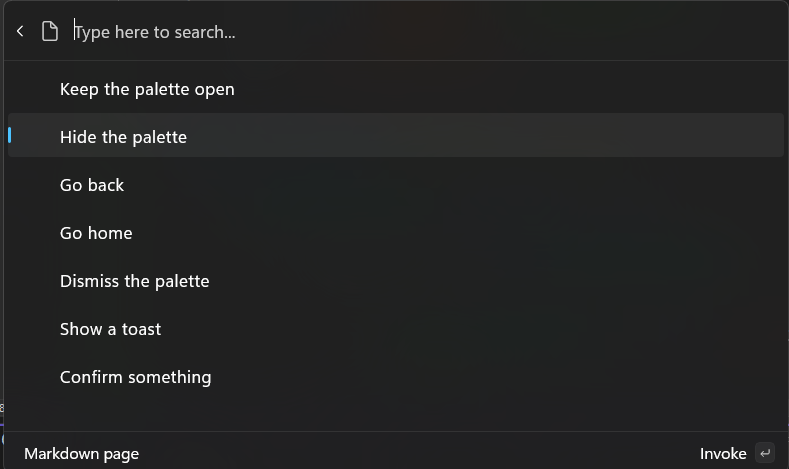Note
Access to this page requires authorization. You can try signing in or changing directories.
Access to this page requires authorization. You can try changing directories.
Previous: Add top-level commands to your extension
An IInvokableCommand represents a single actionable item in the Command Palette—it's what gets triggered when a user selects a command.
When your command is selected, the Invoke method is called. This is where you implement the logic for what your extension should do. The Invoke method must return an CommandResult, which tells the Command Palette how to respond after the command runs—for example, whether to show a message, open a file, or do nothing.
This page explains the 7 different types of CommandResult you can return and what each one does:
Note
There are code examples for the various CommandResult methods listed on this page.
KeepOpen command result
The KeepOpen command result does nothing. It leaves the palette in its current state, with the current page stack and query. This can be useful for commands that want to keep the user in the Command Palette, to keep working with the current page.
Note
Even when returning KeepOpen, launching a new app or window from the Command Palette will automatically hide the palette the next window receives focus.
Hide command result
This command result keeps the current page open, but hides the Command Palette. This can be useful for commands that want to take the user briefly out of the Command Palette, but then come back to this context.
GoBack command result
This result takes the user back a page in the Command Palette, and keeps the window visible. This is perfect for form pages, where doing the command should take you the user back to the previous context.
GoHome command result
This result takes the user back to the main page of the Command Palette. It will leave the Palette visible (unless the palette otherwise loses focus). Consider using this for scenarios where you've changed your top-level commands.
Dismiss command result
This result hides the Command Palette after the action is executed, and takes it back to the home page. On the next launch, the Command Palette will start from the main page with a blank query. This is useful for commands that are one-off actions, or that don't need to keep the Command Palette open.
If you don't know what else to use, this should be your default. Ideally, users should come into the palette, find what they need, and be done with it.
ShowToast command result
This result displays a transient desktop-level message to the user. This is especially useful for displaying confirmation that an action took place when the palette will be closed.
Consider the CopyTextCommand in the helpers - this command will show a toast with the text "Copied to clipboard", then dismiss the palette.
By default, CommandResult.ShowToast(string) helper will have a Result of CommandResult.Dismiss. However, you can instead change the result to any of the other results if you want. This allows you to display a toast and keep the palette open, if you'd like.
Confirm command result
This result displays a confirmation dialog to the user. If the user confirms the dialog, then the PrimaryCommand of the ConfirmationArgs will be performed.
This is useful for commands that might have destructive actions, or that need to confirm user intent.
Example
Below is a page with one command for each kind of CommandResult:
- Open
/Pages/<ExtensionName>Page.cs - Replace
GetItemswith theGetItemsbelow:
using Microsoft.CommandPalette.Extensions;
using Microsoft.CommandPalette.Extensions.Toolkit;
internal sealed partial class <ExtensionName>Page : ListPage
{
public <ExtensionName>Page()
{
Icon = IconHelpers.FromRelativePath("Assets\\StoreLogo.png");
Title = "Example command results";
Name = "Open";
}
public override IListItem[] GetItems()
{
ConfirmationArgs confirmArgs = new()
{
PrimaryCommand = new AnonymousCommand(
() =>
{
ToastStatusMessage t = new("The dialog was confirmed");
t.Show();
})
{
Name = "Confirm",
Result = CommandResult.KeepOpen(),
},
Title = "You can set a title for the dialog",
Description = "Are you really sure you want to do the thing?",
};
return
[
new ListItem(new AnonymousCommand(null) { Result = CommandResult.KeepOpen() }) { Title = "Keep the palette open" },
new ListItem(new AnonymousCommand(null) { Result = CommandResult.Hide() }) { Title = "Hide the palette" },
new ListItem(new AnonymousCommand(null) { Result = CommandResult.GoBack() }) { Title = "Go back" },
new ListItem(new AnonymousCommand(null) { Result = CommandResult.GoHome() }) { Title = "Go home" },
new ListItem(new AnonymousCommand(null) { Result = CommandResult.Dismiss() }) { Title = "Dismiss the palette" },
new ListItem(new AnonymousCommand(null) { Result = CommandResult.ShowToast("What's up") }) { Title = "Show a toast" },
new ListItem(new AnonymousCommand(null) { Result = CommandResult.Confirm(confirmArgs) }) { Title = "Confirm something" },
];
}
}
- Deploy your extension
- In Command Palette,
Reload

Next up: Display markdown content
Related content
Windows developer
